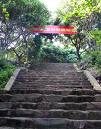|
 (VAN PHUC PAGODA) (VAN PHUC PAGODA)
PHUONG HOANG, TIEN SSON, HA BAC PROVINCE
Phat
Tich Pagoda or Van Phuc Pagoda originally named Thien Phuc Tu - is
situated on the side of Lan Kha mountain, Phat Tich village, Tien Du
district, presently Phuong Hoang village, Tien Son district, Ha Bac
province.
Tourists from Ha Hoi who want to visit the pagoda can take either
of the two routes: the first one will take you along the left bank of
the Duong river. Go along the dyke for 15km, turn left and go on 1km
further down the road you will reach the pagoda. You may also take the
other route by passing Mountain Lim. Then turn right and go on for about
15km, you will arrive at Phat Tich village, looking out on the Duong
river, just about 1km from the dyke.
As recorded in the
historical stele "Van Phuc Dai Thien Tu bi" set up in the 7th Chinh Hoa
year (1686) , "King Ly Thanh Tong(the 3rd king of the Ly dynasty) in the
Long Thuy Thai Binh 4th year (1057), built an exquisite tower of one
hundred truong* in height, set up a gilded statue 6 thuoc ** high. He
also granted over a hundred plots of rice field, built over a hundred
temples"
This recording stele also praised the beautiful sight of
the pagoda: "Let's watch the beautiful spot of Tien Du : the famous
mountain of Phat Tich is surrounded in the south by the Phuong Linh
mountain (Phoenix mountain), on the left by the Thanh Long (blue dragon)
winding stream, on the right by the Bach Ho (white tiger) mountain. On
the summit there stands a stone table"
 In 1071, King Ly Thanh Tong, on his visit to the pagoda,
wrote himself the Chinese character meaning :"Buddha" 6.44m long and had
it engraved on a stone stele to be set up in front of the pagoda. Next,
in the Tran dynasty the pagoda was renamed Van Phuc. King Tran Nghe
Tong ordered to establish the Bao Hoa Buddha shrine and the library Lan
Kha near the pagoda. It was recorded in the "Dai Nam Nhat Thong Chi"
that in 1384, the King held the Examination "Thai hoc sinh" in this
pagoda to select bright scholars for the service of the country. In 1071, King Ly Thanh Tong, on his visit to the pagoda,
wrote himself the Chinese character meaning :"Buddha" 6.44m long and had
it engraved on a stone stele to be set up in front of the pagoda. Next,
in the Tran dynasty the pagoda was renamed Van Phuc. King Tran Nghe
Tong ordered to establish the Bao Hoa Buddha shrine and the library Lan
Kha near the pagoda. It was recorded in the "Dai Nam Nhat Thong Chi"
that in 1384, the King held the Examination "Thai hoc sinh" in this
pagoda to select bright scholars for the service of the country.
In
the Chinh Hoa 7th year, under King Le Hy Tong's reign (1686), the
pagoda was rebuilt on an enormous scale and brought up to a high value
of art. This reconstruction owed its main support to Princess Tran Ngoc
Am, the first royal maid of Lord Thanh Do Vuong Trinh Trang, when she
had left the imperial palace to become a nun in this pagoda. The stele
"Van Phuc Dai Thien Tu Bi" has recorded: "On the mountain summit, stands
a stone building as splendid ass glittering gem… On the front veranda
are displayed 10 animal statues. In the rear are wide ponds. High
storeys are adorned with painted images of phoenixes and twinkling
bright stars and the Moon palace embellished with colourful flowers…"
The
pagoda was built in the shaped interior, shaped exterior" model with
over one hundred compartments. In front of it, stands the
"cloud-reaching tower" as described in the poem "Tien Du Van PhucTu" by
Nguyen Xuong. In the rear are stone houses which are used as lecture
rooms. Close to the pagoda is the Queen Fairy shrine for the worship of
Lady Tran Ngoc Am, in which we can see a pair of parallel sentences
written to honour the lady's good deeds.
 First imperial maid back to Buddha land First imperial maid back to Buddha land
Thirteenth
royal court lady to Fairy village
In the war against the French
invasion, Van Phuc pagoda was destroyed by the foreign invaders. The
remains are now the ruined foundations of 3 floors cut in the mountain
side, of rectangular shapes, each one about 60m in length and 33m in
width. Here, by the years 1940-11941, archaeologists found large bricks
with the dates of Long Thuy Thai Binh 4th year (1057) and Chuong Thanh
Gia Khanh 7th year (1065) clearly inscribed on them. Among the remaining
sculptural masterpieces were found 5 pairs of animal statues: lion,
rhinoceroses, elephants, buffaloes, horses, lying on lotus pedestals
carved out of large stones, slabs about 2m in height. There were also
wall stones, pedestals… with carved images of dragons, musicians,
dancers…
The name of Phat Tich Pagoda was associated with the
Buddha statue - a famous sculptural masterpiece which is now worshipped
in the small pagoda built subsequently. A legend has it that once the
tower of the pagoda suddenly collapsed and the statue came out amid the
ruin. Since then, Hoa Ke hamlet located by the side of the pagoda was
renamed Phat Tich Hamlet. This statue, carved out of stone, is 1.85m
high, or 3m high including the pedestal. The statue represents Buddha
sitting in a meditation posture on a lotus throne. The pedestal is
adorned with, images of dragons, flowers and leaves. The face of the
statue has refined features with an air of serenity and compassion. The
fineness of the carving shows an excellent workmanship.
Translated
by Thuy Duong and Nguyen van Nghe |